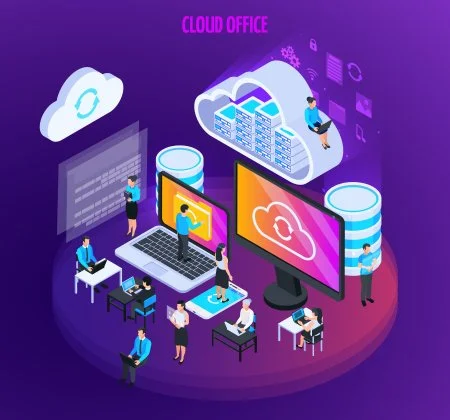Cloud Monitoring is an automated solution that tracks performance in cloud-based IT environments. Most subscription plans do not involve physical modifications to your network infrastructure and typically offer peace of mind without disruption.
Track all elements of your cloud architecture on one consolidated dashboard to gain visibility into how each component fits together and gain insight into key business metrics like cost per customer to make informed engineering and business decisions.
Cloud Monitoring Definition
Cloud monitoring refers to collecting, reviewing and accessing key operational data from an organization's cloud-based infrastructure or applications to gain insights that enable users to make more informed decisions regarding the performance, security and availability of cloud services and infrastructure. It aims to give users actionable intelligence to make changes that improve these areas.
Cloud monitoring also plays a key role in application performance by providing visibility into how cloud infrastructure components and applications interact, helping teams identify bottlenecks before they impact end users and helping businesses meet SLA commitments while avoiding high cloud service usage fees by tracking provider performance and capacity.

The top cloud monitoring tools enable organizations to track various parameters, from virtual machine health and uptime, SDN, Kubernetes storage and databases. These tools offer one integrated platform for metrics, uptime dashboards and alerts, saving IT staff from switching systems often for monitoring purposes. They can even automatically determine or define SLOs for each application with alerts when these are violated.
Operations teams managing hundreds of cloud services must prioritize relevant information while eliminating noise to identify real warning signs that could otherwise go undetected. They also need to track each service's performance and dependencies, as this data can enable smarter cost-cutting decisions - particularly essential for businesses seeking to maximize their return on infrastructure investments.
Cloud Monitoring Tool
Cloud monitoring tools are software solutions designed to monitor a cloud infrastructure's operating workflow and processes. By collecting information from all layers of the structure, admins can use these tools to assess performance and security across their systems and networks; IT personnel can use them to detect potential issues that could interfere with service delivery before taking remedial actions before they cause major issues.
While various monitoring tools are available, certain ones excel in monitoring specific aspects of cloud infrastructure. For instance, some solutions are tailored specifically for monitoring individual VMs in an IaaS environment. In contrast, others track and analyze logs, metrics and traces across an entire system - providing IT teams with an overall view of how their systems function and faster resolution of any issues.
Sematext Cloud offers easy setup and provides in-depth visibility into key cloud services with its centralized view of performance indicators and logging capabilities. Furthermore, Sematext Cloud tracks microservice performance across multi-cloud environments by tracking microservice metrics in an interactive dashboard view that lets teams proactively detect performance bottlenecks for improved operational efficiency of cloud infrastructures. In addition, it offers various other features to enhance operational efficiencies:
Implementing cloud monitoring tools is crucial to optimizing cloud infrastructure for faster, more reliable services and providing users with an exceptional digital experience.
How Does Cloud Monitoring Work?
An effective cloud monitoring tool can also assist organizations in tracking how much their cloud services cost and usage trends to predict their growth in the future. Furthermore, such monitoring tools can detect anomalies requiring IT teams' attention for proactive problems with virtual machines, Kubernetes clusters, storage solutions or databases in their cloud infrastructure environment.
An ideal cloud monitoring solution should easily support private, public and hybrid cloud environments. A central dashboard should enable real-time visualizations from multiple sources and forecasts of key metrics. As workloads move across different servers, real-time monitoring should allow it to adjust server provisioning accordingly and maintain optimal performance levels. Finally, an effective server monitoring solution should allow administrators to set baseline activity levels for each app, automatically adding or subtracting servers as necessary for optimal performance. This feature is particularly important when dealing with Software-as-a-Service (SaaS) solutions such as Office 365 or Salesforce that rely on other servers being available to function optimally - such solutions require reliable availability of other servers.
Benefits of Cloud Monitoring
Cloud monitoring offers more advantages than just basic server and application performance metrics. A good monitoring solution enables organizations to track how many cloud services they utilize, track usage fees, and protect against data breaches while discovering and fixing errors in cloud-based apps before they impact end users - ultimately improving user experience.
Cloud monitoring tools come in two forms - as part of your cloud provider's service or as standalone software - providing an integrated approach that reduces overhead while giving access to the latest features and functionality; alternatively, subscription-based monitoring software offers greater scalability options.
No matter the cloud monitoring tool you choose, ensure it provides key metrics and alerts that enable the engineering team to act swiftly when issues arise - this allows quick remediation when issues occur, decreasing downtime while decreasing service disruption costs. Search for a platform with an easy and user-friendly monitoring and alert management interface while being compatible with existing tools and infrastructure. This will save both time and resources while simplifying engineering, helping improve NetOps processes, and reducing security risks such as mean time to detection (MTTD) and mean time to resolution (MTTR), leading to increased business value for your organization.
Cloud Monitoring Best Practices
Appropriate cloud monitoring tools can assist in the management of cloud-based applications. These solutions offer a holistic view of application performance so you can optimize them to meet and surpass end-user expectations. They also show key metrics showing the cost breakdown of cloud instances and predict growth trends. In addition, many provide notification methods like emails, text messages, Slack notifications etc., for when issues arise - this way, you can monitor apps from any internet-enabled device such as computers, smartphones or tablets!
As you evaluate cloud monitoring tools, ensure they cover your business requirements. An ideal cloud monitoring solution should support on-premise infrastructure and cloud services and report their data in one consolidated platform. A data analytics solution should enable you to quickly analyze and uncover solutions in your data while simultaneously isolating metrics from their sources to avoid cluttering insights that could provide important information. A top cloud monitoring tool should normalize and treat all data collected identically, making it easier to detect anomalies and understand what's happening within your infrastructure. Furthermore, an effective cloud monitoring solution allows you to set alerts for certain events, which can trigger different workflows and processes.
